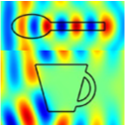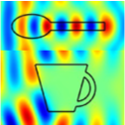More illusory than invisible
Optical cloaking, a phenomenon that once only had connotations of Hollywood and science fiction, recently moved from fantasy to reality. In 2006, researchers effectively rendered an object invisible by sheathing it in an “invisibility cloak” made of a metamaterial [1], which is a class of artificial composite materials with electromagnetic properties that are more varied than those of their constituents.
Recently, Yun Lai and coauthors at the Hong Kong University of Science and Technology proposed the concept of “cloaking at a distance” with a specially designed metamaterial [2]. Now, in a paper appearing in Physical Review Letters, they go a step further. Using the techniques of transformation optics, which allows Maxwell’s equations and topology to bend the space through which light passes, they describe how a particular object could be optically transformed into another: a spoon may appear to be a cup, or one may see a peephole where there is really a solid wall. Rendering an object invisible then becomes one case out of many possible illusions. We await the experimental realization. – Sami Mitra
[1] D. Schurig et al., Science 314, 977 (2006).
[2] Y. Lai et al., Phys. Rev. Lett. 102, 093901 (2009); T. Philbin, Physics 2, 17 (2009).





